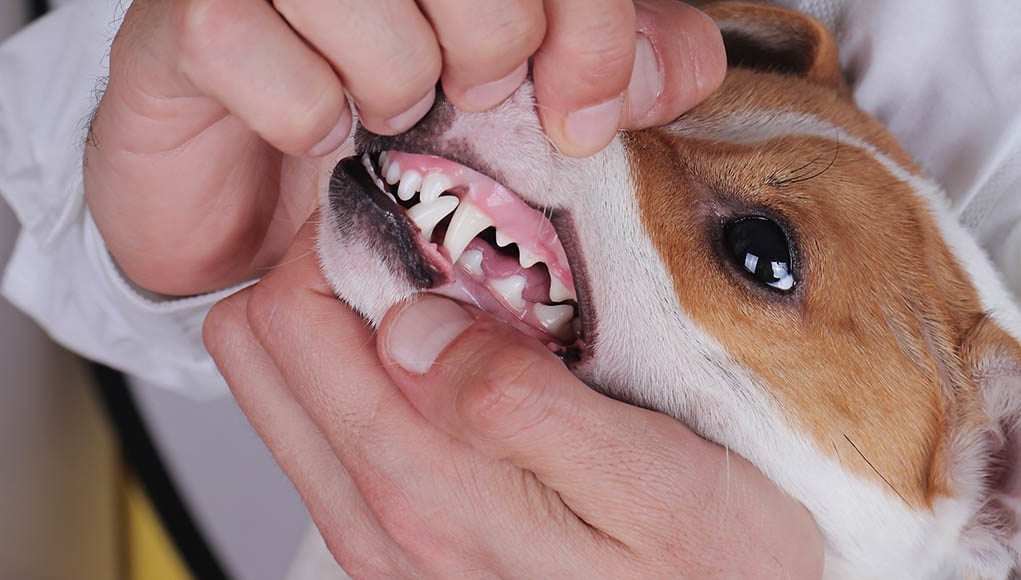Table of Contents
Have you noticed that your dog's gums are a little swollen? Is the color not normal?
In this article, we'll tackle everything you'll need to know about red gums in dogs.
Gums, most of the time, get overlooked as an important part of our oral health. A dog's gums are not just there to keep its teeth in place.
Red gums in dogs are usually signs of dental problems.
If you don't know by now, checking the color of your dog's gums can help you have an idea of their health.
The color of a dog's gums can indicate different kinds of health issues.
For instance, bright red gums in dogs are different if the gums are brown.
But before we get into red gums in dogs, let's first tackle what normal gums look like.
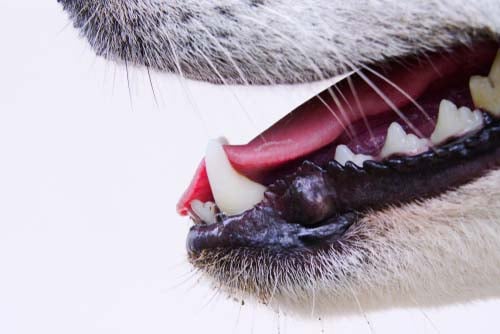
Red Gums In Dogs: But What Do Normal Gums Look Like?
If you're curious about what healthy gums look like, the color should be a light pink hue.
Since the gums are a great indicator of several health problems, you should make it a routine on checking them.
If you're looking to check if your dog has healthy gums, you can use the test called Capillary Refill Time (CRT).
In Capillary Refill Time, a healthy gum, when pressed lightly, should turn pale. But once you take the pressure off, it should return to its normal bubble gum pink color within two seconds.
So what color of a dog's gum should you be worried about? Different colors have different possible meanings.
For instance, if you see your dog's gums are colored blue, it can mean that inadequate oxygen is being circulated through your dog's blood supply.
If your dog's gums are white or pale, this can mean a lack of blood or hemoglobin.
Yellow gums in dogs can indicate that red blood cells are damaged or it can also mean the liver has been damaged.
Also, brown gums in dogs can mean paracetamol toxicity.
On the other hand, what does it mean when a dog has red gums? Scroll down and let's dive in!
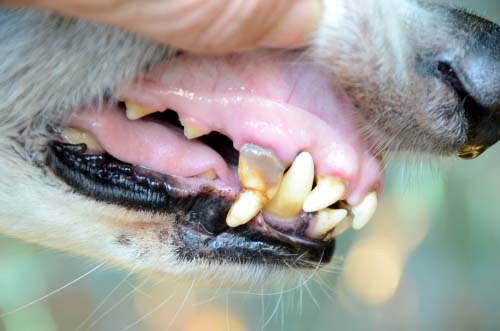
Red Gums in Dogs and What It Means
Red gums in dogs can indicate plenty of things. It also depends on what kind of red is it.
For instance, if a dog's gums are bright red, it can indicate they are overheated.
Below is a short list of possible causes of red gums in dogs.
Dehydration and Overheating
Having bright red or blue gums is one of the symptoms of dehydration or overheating in dogs.
So when does dehydration occur? Dehydration happens when a dog loses more body fluids than they are drinking.
Water can easily be lost when dogs are panting, urinating, defecating, or vomiting.
It can also be lost through evaporation through the paw pads.
On the other hand, overheating is a much more serious problem. It can be fatal if not treated immediately.
Dogs can suffer from heat exhaustion, heat stroke, or death. In fact, heat stroke is distinguished by a body temperature that is higher than 103° F or 39.4°C.
Other heatstroke symptoms include:
- Panting
- Lethargy
- Increased heart rate
- Vomiting
- Diarrhea
- Collapsing
- Seizure
Petechiation (Bruising)
If you see bright red or dark spots in your dog's gums, it can be a sign of Petechiation. It is a technical term for bruising.
Symptoms of bruising on the gums can mean that there's a defect with the normal clotting mechanism of the dog's body. This includes platelets and other clotting elements produced by the liver.
Usually, Petechiation is seen when there is rat poison ingestion. Beware because some rat poisons can interfere with clotting factors that lead to bruising.
Gingivitis
One of the most common culprits of red gums in dogs is Gingivitis. It is the medical term for inflammation of the gums.
It's also important to take note that Gingivitis is the first stage and the only reversible stage of Periodontal Disease.
Gingivitis is usually caused by a bacterial infection from plaque due to poor oral hygiene.
Bacteria can enter the small spaces between the gums and teeth, which causes an inflammatory reaction.
If left untreated, the infection can spread to the surrounding tissues that hold and support the teeth and will eventually result in tooth loss.
It can also make your pet vulnerable to heart, kidney, and liver diseases when the bacterial infection enters the bloodstream and reach these organs.
Other symptoms of Gingivitis are:
- Bad breath
- Swollen Gums
- Bleeding Gums
- Yellow Teeth
- Loss of Appetite
- Loose Teeth
- Excessive Plaque and Tartar buildup
Stomatitis
Furthermore, another dental disease that can cause red gums in dogs is stomatitis.
Also known as Chronic Ulcerative Stomatitis (CCUS), stomatitis is a more generalized inflammation of the mucous membranes in the mouth.
This problem involves not just the gums, but also the tongue, inner surfaces of the lips, and the floor or roof of the mouth.
Unfortunately, the exact cause of stomatitis is still unknown.
But stomatitis is an immune system reaction to calculus and plaque on the teeth.
Other signs of Stomatitis are:
- Excessive Drooling
- Bad Breath
- Loss of Appetite
- Mild to Severe Gingivitis
- Bleeding Gums
- Bloody Saliva
- Weight Loss
Difference Between Stomatitis and Gingivitis
Pet owners get confused sometimes because Gingivitis and Stomatitis are both inflammatory problems that affect their dog's oral health.
So what is the difference between the two?
Firstly, even though the symptoms are somewhat similar, they both have different causes.
Stomatitis is a more severe form of inflammation than Gingivitis. It is also more painful to dogs that it'll cause them to not eat.
Moreover, Stomatitis can be managed through drug therapy, but if you want a complete cure to this disease, a full-mouth extraction of the teeth will be needed.
On the other hand, Gingivitis is easier to treat—with proper dental hygiene and regular brushing, you can avoid this dental issue.
Also, if left untreated, Stomatitis can help Gingivitis develop and that can lead to Periodontal Disease.
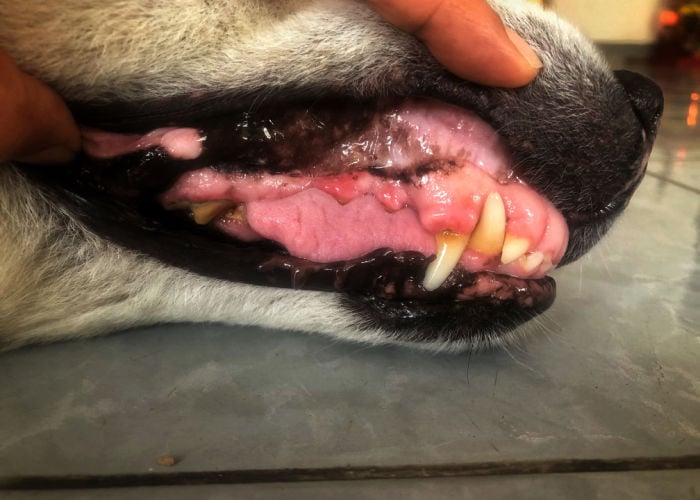
Other Causes of Red Gums in Dogs
Furthermore, there are still possible conditions that can cause red gums in our dogs. A few examples are:
Aging
Dogs' gums tend to turn red or swell when they are at their advanced age.
Toxicity
Red gums can also be caused by something poisonous.
For instance, if Fido accidentally eats a toxic plant or a poisonous toad.
Crowding Teeth
Sometimes, young dogs have too many teeth that they'll not fit the size of their mouth.
That's when their gums become impacted or red.
Injury from Foreign Objects
There are occasions when a dog chews too hard on a sharp object. Their gums can bleed due to simple cuts and scrapes.
When foreign objects get stuck between their teeth, it can cause redness or bleeding.
Warts on the Gums
Also known as Papillomatosis, warts on the dog's gums happens usually in younger dogs.
Larger dog breeds like Labrador Retrievers are also prone to this condition.
Fortunately, these warts fall off on their own most of the time.
Diagnosing Red Gums in Dogs
As dog owners, we want what's best for our pets. That's why we don't recommend just googling answers when it comes to Fido's health.
If you see something unusual or out of the ordinary with their actions or with their body, it is best advised to consult with your vet at once.
To diagnose the right problem with red gums in dogs, your vet will need to run a complete physical exam and examine their teeth and gums.
Moreover, your vet might also need dental x-rays of the teeth and gums to determine if the cause is gingivitis, stomatitis, periodontal disease, or trauma.
Fortunately, this test will be done under anesthesia.
Also, urine and blood tests can be done to know if there are any underlying medical conditions.
A CT scan or an MRI can also be done if your vet suspects a more serious disease like tumors or cancers.
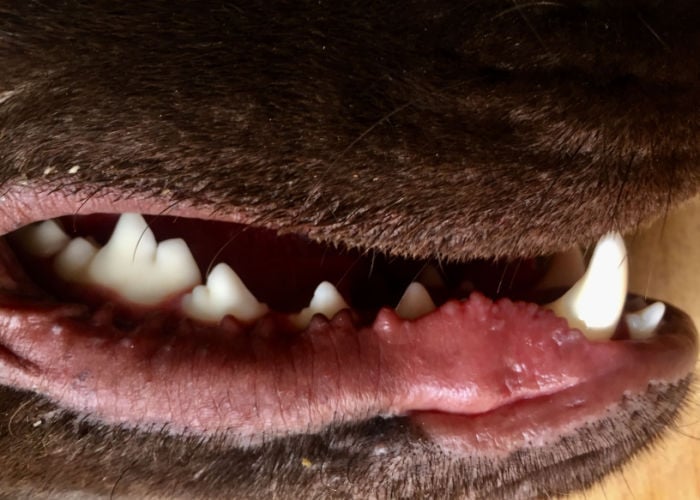
Treatment of Red Gums in Dogs
Treatment for red gums in dogs will vary. It will depend on the diagnosis of your vet.
There are different treatments for different causes.
For instance, if your vet says that your dog has stomatitis, it all starts with a professional dental cleaning.
This includes thorough teeth cleaning, polishing, and extractions may be required.
If the dog is dehydrated, immediate treatment is crucial, especially if the dog is showing signs of shock or heatstroke.
Typically, they'll be treated with intravenous fluids to rehydrate them.
Frequently Asked Questions
How do you tell if your dog has inflamed gums?
To check if your dog has gingivitis or inflamed gums, simply brush their teeth. Usually, inflamed gums bleed when brushed.
What do vets do for gingivitis?
When a dog has gingivitis, its vet will perform a deep cleaning of the gums and teeth to eliminate plaque and tartar.
However, that's just the first step of the healing process.
The next step will be conducted by you, the pet owner.
Even if the vet has removed the tartar on their mouth, those gum-eating elements of bacteria will still come back.
As their guardian, we must prevent this by brushing their teeth every day using vet-recommended toothpaste.
What can I feed a dog with gingivitis?
A lot of pet owners resort to soft dog foods when their dogs have dental problems.
Also, there are now specially formulated dog foods that help a dog's dental health like Hill's Prescription Diet Dental Care Dry Dog Food or Hill's Science Diet Dry Dog Food.
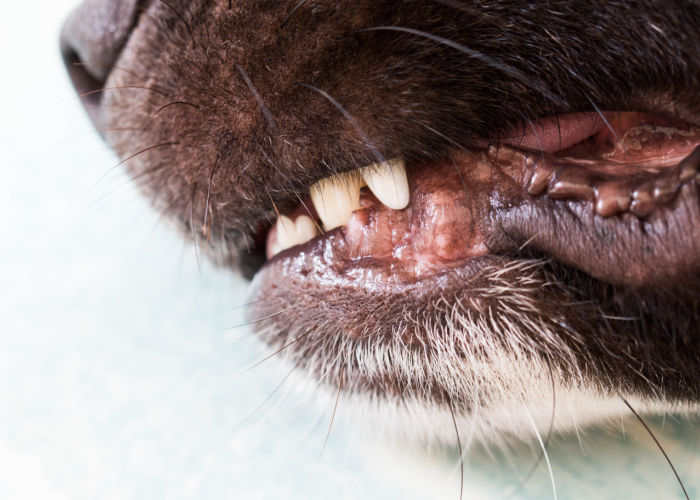
Red Gums In Dogs: Summary
A dog's gums are still one of the most important parts of its oral health.
They don't just hold their teeth together. It's much more than that.
In some cases, you can see a dog's health condition by looking at the color of its gums.
Red gums in dogs can be caused by numerous things. For instance, bright red gums in dogs can indicate dehydration or overheating.
On the other hand, red gums can also mean that your dog might be suffering from Gingivitis or Stomatitis.
But red gums can also indicate that they have just injured their gums from eating a toxic substance or piercing their gums by chewing a foreign object.
As pet owners, we must keep an eye on our dogs. Be aware of what they eat.
Give them proper dental hygiene to prevent these health problems.


